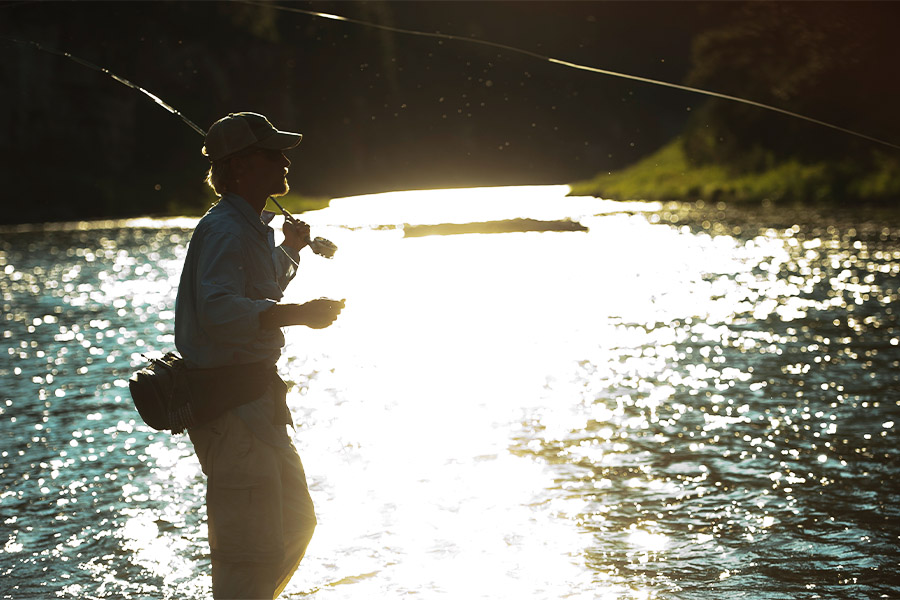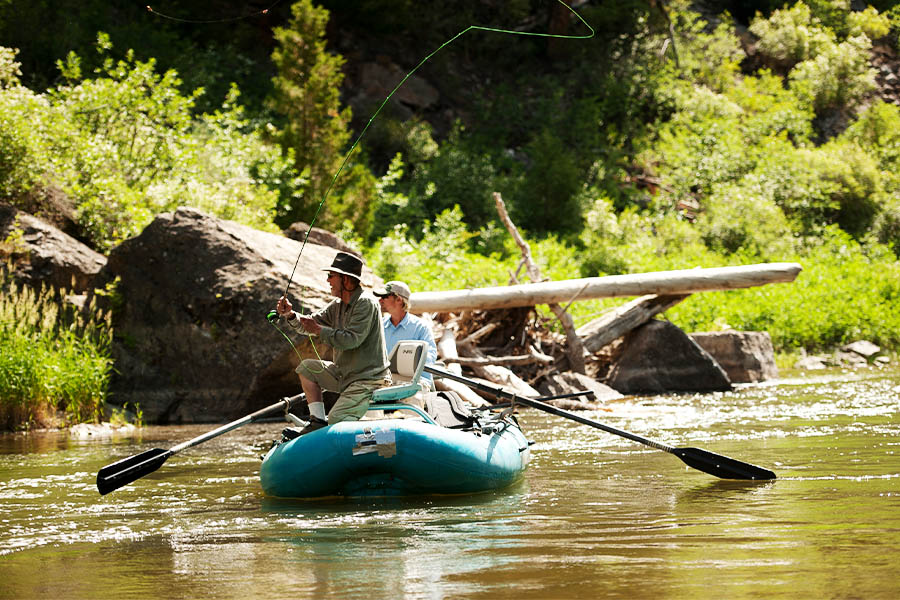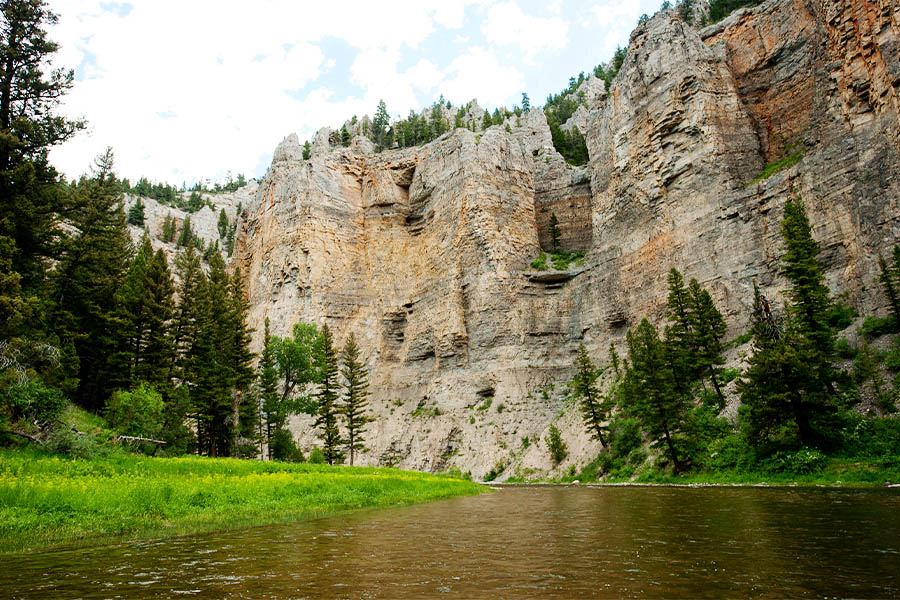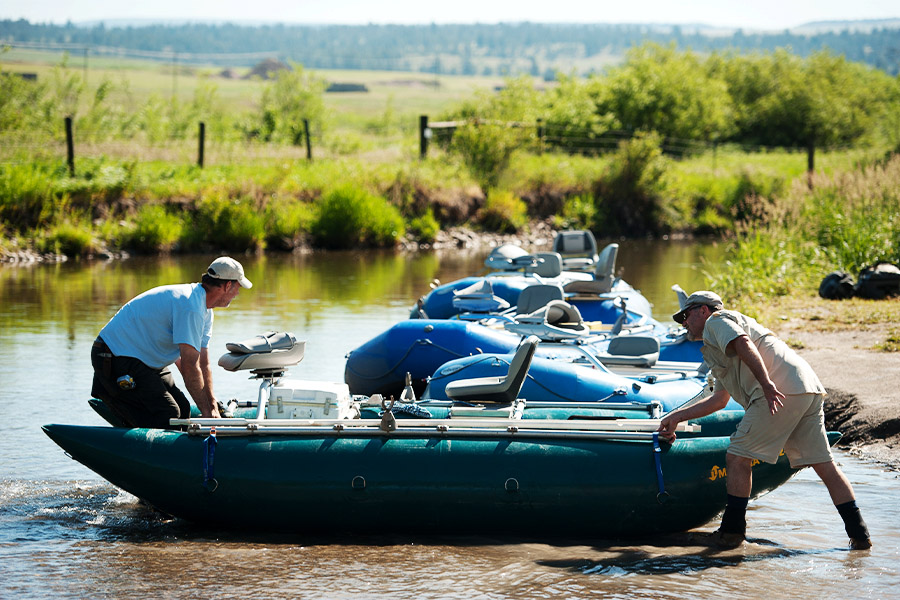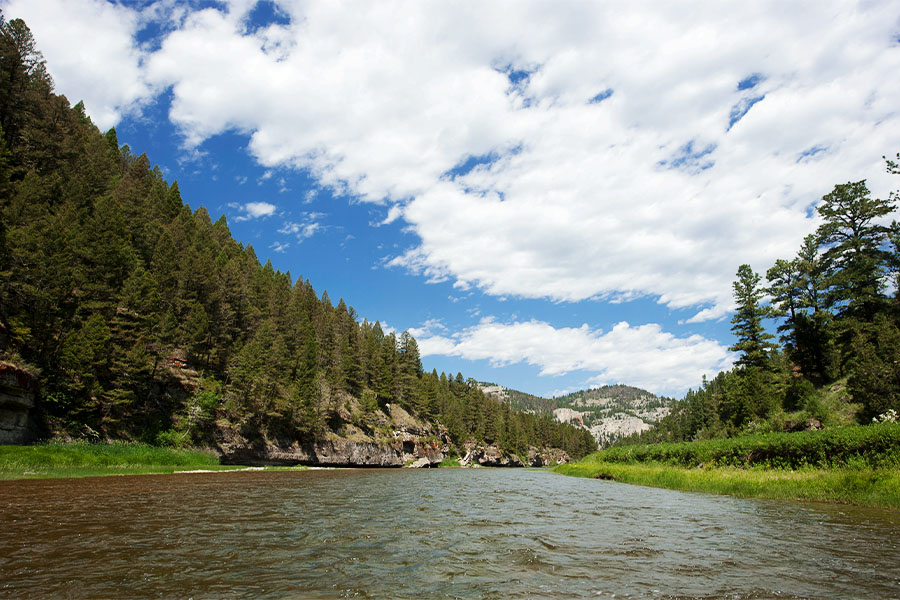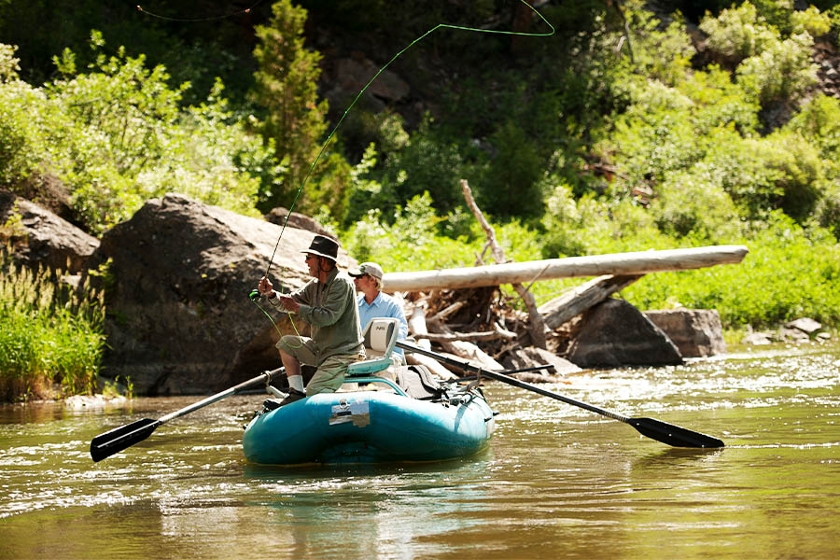Smith River State Park offers gorgeous scenery in a remote setting. Renowned trout fishing is just one of the recreational opportunities that make a float trip on the 59-mile Smith River an unforgettable experience.
The Smith River is so popular that a permit is required to float it. The permit process allows visitors a quality, multi-day float in relative solitude.
Smith River State Park has one put-in point (Camp Baker) and one take-out point (Eden Bridge) for the entire 59-mile stretch. The river is accessible only by non-motorized watercraft, including; rafts, canoes, kayaks and drift boats. Rowers and paddlers should have at least intermediate level skills. On average, visitors take four days to float the river.
From May 15 - July 15 floaters can stay on the river a maximum of four nights only. To help preserve the unique quality of the Smith River canyon, overnight camping must take place at designated boat camps.
Since the Smith River flows through a remote canyon, there are some things to keep in mind for this adventure; there are no public services from Camp Baker to Eden Bridge. Floaters must carry their own food, water, safety, camping equipment and a fishing license. It is advisable to bring all the drinking water you will need for the duration of your trip, as there is no drinking water available at the put-in location of Camp Baker. Also, Camp Baker does not have trash dumpsters, but one is available at the Eden Bridge takeout point along with aluminum-recycling bins.
Floating the Smith River requires careful planning and preparation. The following are questions that FWP personnel are often asked. Please call the Great Falls FWP office at (406) 454-5840 if you have any additional questions.
Q. When is the float season?
The float season varies widely depending on snow pack, rainfall and amount and timing of irrigation. The “typical” float season runs from mid-April through mid-July, with occasional floating opportunities in September and October. A permit and payment of fees is required to float year-round.
Q. When do I register, choose my boat camps and pay float fees?
Floater registration will occur via phone two days in advance of the permit holders’ launch date. River Rangers will call permit holders, in a randomly selected order, between 1:00 and 3:30 p.m. MDT to complete the registration process, which includes listing party members and number and type of watercraft, choosing boat camps and paying float fees via credit card (Visa or Mastercard). In addition, the River Rangers will assign a “one-hour” time interval for each float group to approach the boat ramp to launch. This time interval will be based upon float distance to the first night’s camp. If you need to make alternate arrangements for the phone registration, due to the inability to take a call at that time or the desire to have another party member complete the registration, please call the reservation clerk at 406-454-5861.
On launch day, float groups will receive their copy of the registration form, boat tags, river maps and floater log and will be required to attend a mandatory safety and orientation talk prior to launching.
Q. How soon do I need to arrive at Camp Baker?
Camp Baker is managed as a “day use only” site, with no overnight camping allowed, except for the period of Sept. 1 through Nov. 30. Float groups are encouraged to arrive at Camp Baker a minimum of one hour prior to their scheduled boat ramp launch time on their launch date, to prepare boats and equipment in the staging areas, off and away from the boat ramp. Please check-in with the River Ranger, or site host, who will direct you to an appropriate staging area for your party and arrange for the orientation and safety talk once all party members arrive.
Q. What is the procedure once I arrive at Camp Baker?
Upon arrival on the day of your scheduled launch date, please check-in with the River Ranger or site host. They will direct you to an appropriate staging area for your party and arrange for the orientation and safety talk once all party members arrive. This is where you may begin preparing boats and equipment prior to your scheduled “one-hour” boat ramp launch time. The River Ranger, or site host, will deliver your packet of materials which includes a copy of your registration form, boat tags, river maps and a floater log. The ranger, or site host, will present the mandatory safety and orientation talk at some point prior to your “one-hour” boat ramp launch time.
Q. When can I begin staging gear and/or boats at the boat ramp?
During the registration process via phone two days prior to the launch date, the River Ranger will assign a “one-hour” boat ramp launch time. Please do not approach or occupy the boat ramp prior to your scheduled launch time, or until a River Ranger or site host has granted permission. Prepare boats and gear in the staging areas adjacent to the boat ramp. Please be prepared to have boats loaded and ready to shove off within the scheduled “one-hour” time interval. Please do your best to share the ramp and respect other users.
Q. How many days does it take to float the Smith River?
The float is 59 river miles from Camp Baker (put-in) to Eden Bridge (take-out). On average, floaters take four days to float. A minimum of two nights and three full days should be planned for normal water levels, which is 300+ cfs. Factor in probable river flows, distances you wish to cover each day and the type of experience you are seeking.
Q. Is there a limit to the number of nights allowed on the Smith River?
Yes. During the peak season of May 15 through July 15, floaters are limited to a maximum of four nights camping. The four-night limit includes nights spent at private cabins or guest ranches. Layover nights (two or more nights at the same camp) are permitted at mid-canyon boat camps (Two Creek to Upper Parker), however, only one layover night is permitted during the high use season (May 15-July 15).
Q. Can we camp and fish anywhere on the Smith River?
No. Of the 118 miles of shoreline along the river, only 26 miles are public land. There are 27 boat camps with 52 campsites along the river located on National Forest land, FWP land, DNRC state land and leased private land. The boat camps are signed and marked on the Smith River maps, which are distributed at Camp Baker upon registration. Please camp only at the designated boat camps. The Montana Stream Access law allows walking and fishing along the river within the ordinary high-water mark. As a courtesy to landowners, please refrain from stopping in front of cabins and homes along the river.
Q. What type of fish are in the Smith River?
The Smith River is predominantly a rainbow and brown trout fishery. Whitefish are also common. A complete list of the fishing regulations can be found in the Montana Fish, Wildlife & Parks Fishing regulations which are available anywhere fishing licenses are sold. Please note that fishing licenses are not sold at Camp Baker but may be purchased in the nearby town of White Sulphur Springs at Twin Sisters Trading Company or Castle Mountain Grocery.
Q. What special regulations apply to floating the Smith River?
The Smith River is managed as part of the Montana State Parks System and in cooperation with the Helena-Lewis and Clark National Forest. Fees and rules for Smith River State Park and River Corridor are established under the authority of the Smith River Management Act and the Biennial Smith River Fee Rule (PDF). Regulations specific to the Smith River can be found on page 8 of the Floater Information Packet. State Park Public Use Regulations (PDF) also apply in the corridor pertaining to littering, fires, firearms, fireworks, disorderly conduct and the prohibition of drones.
- HUMAN WASTE MANAGEMENT – PACK-OUT REQUIRED: All private and commercial float parties are required to pack-out their human waste from the Smith River corridor. Montana Fish, Wildlife & Parks (FWP) has identified and approved multiple types of portable, hard-sided toilets acceptable for human waste disposal Approved Portable Toilets. Two SCAT (Sanitizing Containers with Alternative Technology) machines, that will allow for safe and convenient human waste disposal of the various toilets, have been installed at the Eden Bridge take-out. The SCAT machines not only allow for disposal but will also clean (wash out) and sanitize the approved portable toilets. Alternative waste disposal systems, including bag systems (i.e. Clean Waste, RESTOP2 etc.) are not permitted. Additional details, including photographs, videos and instructions for the portable toilets and SCAT machine, can be found on the Smith River Website.
-
FOOD STORAGE REGULATION: Food, garbage and other attractants must be stored securely in an IGBC approved bear resistant device such as a cooler, container and/or within electric fencing. Attractants may also be suspended at least 10 feet from the ground and 4 feet horizontally from a vertical support. All approved food and attractant storage methods or equipment must be installed and/or utilized in accordance with the manufacturer’s specifications. For example, all approved coolers must be locked using either two padlocks or two threaded bolts and nuts. If using a padlock, we highly recommend a combination lock versus a keyed lock, since keys are easily misplaced or lost. If using bolts and nuts, we highly recommend bring multiple spares in case you lose them.
There are currently three manufactured portable electric fences available for sale and/or rent on the market that meet the IGBC standards. However, some floaters may choose to construct a homemade fence and/or already possess a homemade fence that they’ve used elsewhere. If this is the case, the fence must meet required specifications.
The original 7-strand electric fence developed by the USFS Technology Development Center is also an acceptable food storage option. However, this fence is more applicable to use in situations involving longer term base camps where the fence is in place for several days.
Learn more ways you can Be Bear Aware (PDF)
Complete list of approved Interagency Grizzly Bear Committee (IGBC) products
Q. Is there a maximum group size for floating parties?
Yes, maximum group size for private and outfitted groups is 15 people.
Q. What services are offered on the Smith River?
The Smith flows through a remote canyon. There are no public services from Camp Baker to Eden Bridge. You must carry all your own food, water, safety and camping equipment and fishing license. It is advisable to bring all the drinking water you will need for the duration of your trip, as there is no drinking water available at Camp Baker. There are no trash dumpsters at Camp Baker, but two are available at the Eden Bridge takeout along with an aluminum-recycling center. You can obtain supplies, overnight accommodations, gasoline, water and information at White Sulphur Springs on your way to the put-in. You should top-off your gas tank while in White Sulphur Springs. Cascade, Great Falls and Ulm are the closest services to the Eden Bridge takeout, with gas stations at each town.
Q. Can I hire a person to perform services for me during my float trip (Example: Row gear boat, cook meals, camp set-up etc.)?
No. Hiring a person, group or organization to perform any type of service for compensation during a private permitted float trip on the Smith River is illegal outfitting. There are seven (7) commercial outfitters who are authorized and permitted by Montana State Parks and the United States Forest Service to conduct commercial float trips on the Smith River. However, these outfitters are allocated a specific number of launches on specific days throughout the float season and conduct fully outfitted float trips for persons not possessing a private float permit. They are not authorized to provide specific services for private permit holders.
Q. Is there whitewater on the Smith River?
Throughout its length, the Smith moves quickly with sharp turns, rocky shallows and snags in/or partially across the river. There is one section of class II whitewater at river mile 47 and several sections of class II whitewater at mile 49. The current of the river can sweep you into sheer rock walls and in higher flows, eddies can be very strong. In addition, floaters may encounter float gates, downed trees and pieces of fence torn loose by high water. You should possess, at a minimum, intermediate rowing or paddling skills before floating the Smith. Secure all equipment tightly in your boat and carry your gear in waterproof bags or boxes.
Q. What kind of boats can be used on the Smith River and at what river flows?
The Smith River is a non-motorized river. Rafts are used by about 80% of floaters; canoes by 5% and the remaining 15% of boats on the Smith are other types of craft such as drift boats and kayaks. Rafts and canoes are the most appropriate craft, although inflatable and solid-body kayaks, rowboats and drift boats are also taken down the river. Drift boats are particularly difficult during low water conditions. To help floaters, Montana State Parks recommends minimum flows for different types of watercraft. Drift boats generally begin to have trouble at river flows below 350 cfs, rafts below 250 cfs and canoes below 150 cfs. This does not mean that different watercraft types will not have trouble floating at levels above those given. These are estimated levels listed to assist floaters in planning their trip. Remember that the river is always changing, and you should adjust accordingly. Feel free to contact the ranger at Camp Baker 406-547-3893 to ask about current flow levels and up to date information and advice on floating conditions.
Q. How can I find out about flow levels?
Visit the Montana USGS Web site at SmithRiverFlowGauge. This streamflow monitoring gauge is named, “Smith River bl Eagle Cr nr Fort Logan MT” and is located approximately 1.5 miles downstream of the Camp Baker put-in.
Q. What other type of equipment should we bring?
Expect all types of weather conditions, especially in the spring. Snow is possible and quite common in April and May and occasionally in June. The Smith River flows between the Little Belt and Big Belt mountain ranges, which are conducive to dramatic and quick weather changes. Bring good raingear, a complete first aid kit, adequate warm clothing, sunscreen, an extra paddle or oar for each boat, boat repair equipment and supplies, an extra day of food, extra life jacket, extra firewood and a five-gallon bucket and shovel for extinguishing fires. The five-gallon bucket is also useful for washing your boats during and after your float trip. In addition to the equipment you plan on using to comply with the mandatory Food Storage Regulation, we also strongly encourage you to bring bear pepper spray.
IN ACCORDANCE WITH STATE LAW, EVERY BOAT MUST HAVE A LIFE JACKET ON BOARD FOR EACH PERSON. IT MUST FIT THE INTENDED WEARER, BE READILY ACCESSIBLE AND IN GOOD CONDITION. CHILDREN UNDER 12 ARE REQUIRED TO WEAR A LIFE JACKET AT ALL TIMES WHILE IN A BOAT THAT IS IN MOTION.
Q. How do we dispose of human waste?
All private and commercial float parties will be required to pack-out their human waste from the Smith River corridor. Montana Fish, Wildlife & Parks (FWP) has identified and approved multiple types of portable, hard-sided toilets acceptable for human waste disposal Approved Portable Toilets. Two SCAT (Sanitizing Containers with Alternative Technology) machines, that will allow for safe and convenient human waste disposal of the various toilets, have been installed at the Eden Bridge take-out. The SCAT machines not only allow for disposal but will also clean (wash out) and sanitize the approved portable toilets. Alternative waste disposal systems, including bag systems (i.e. Clean Waste, RESTOP2 etc.) are not permitted. Additional details, including photographs, videos and instructions for the portable toilets and SCAT machine, can be found on the Smith River Website.
Q. Can we have campfires along the Smith River?
Yes. However, it’s highly suggested that you arrive at Camp Baker with your own supply of firewood or purchase it at Camp Baker ($8 per bundle). No person may cut living or dead standing trees for firewood or other purposes. Gathering dead native wood deprives many animals of shelter from high summer and low winter temperature extremes. The same principle applies to driftwood found along the riverbank, as it serves as habitat shelter for fish. If you find it necessary to gather firewood, avoid stripping an area of its entire supply. Help to enhance the feeling of solitude in the canyon by not using a chainsaw. Please use the metal fire rings within each boat camp and make sure all wood is completely contained within the fire ring and that your fire is dead out before leaving. The most common type of litter left at campsites is half-burned plastic, aluminum foil, glass, eggshells, cigarette butts and melted aluminum cans left in the fire rings. Do not attempt to burn anything in the fire ring besides paper, wood or charcoal. Clean your fire ring after extinguishing your fire. If you plan on camping at the Camp Baker put-in (permitted 9/01 – 11/30 only) and having a fire, the same Leave No Trace principles as above apply.
Q. Why are there fences across the Smith River?
The Smith River flows through a great deal of private land. Ranchers along the Smith River graze livestock, particularly during the late summer and early fall. In some places, fences have been installed across the river to control livestock. Most fences will have float gates installed with the cooperation of the landowner, allowing safe passage of your boat. Use caution when approaching and passing through the float gates. Please repay the favor by respecting the landowner's property rights. Don't cut fences, camp on private land without permission, litter or vandalize equipment. Please respect cabin owners’ privacy by not stopping in front of their cabin sites. Realize that only through cooperation between the landowner and floaters will the Smith River continue to be used and preserved by all.
Q. Are dogs allowed on the Smith River?
Dogs are not allowed on Smith River float trips. The only exceptions are legitimate service dogs Service Animals FAQ's that accompany someone with a disability and hunting dogs used for lawful hunting purposes during legal hunting seasons. Aside from these two exceptions, no dog or pet will be allowed on a Smith River float trip. Keep in mind that there are no kennel options at Camp Baker; if you bring a dog or pet to Camp Baker, they will not be allowed to accompany you down the river and you will not be permitted to leave the animal at Camp Baker. Thank you for your compliance.
Q. Are shuttle services available?
Yes. Several shuttle services can move your vehicle from Camp Baker to Eden Bridge. A current list of shuttle services is included on pages 14-16 of the Floater Information Packet.
Q. How do I get to the Camp Baker put-in?
White Sulphur Springs to Camp Baker is 26 miles. Take State Secondary Road 360 (Fort Logan Road) west from White Sulphur Springs 16.6 miles to the Camp Baker turn-off. Follow the directional signs 9.6 miles to Camp Baker. It takes two hours (75 miles) to drive from Camp Baker to Eden Bridge on Millegan Road (State Secondary Road 360). Driving this gravel road (Millegan Road) should not be attempted during wet conditions. Please obey posted speed limits on all roadways and be observant for wildlife, livestock and/or ranch machinery. Make sure to lock your vehicles and leave no valuables in your vehicle at Camp Baker or Eden Bridge. Eden Bridge is 28 miles from Great Fall via Ulm and Interstate 15. Great Falls to Camp Baker via White Sulphur Springs is 127 miles.
Q. Are commercial outfitters allowed on the Smith River?
Yes, but they are strictly limited, both in the total number of outfitters and the number of launches that each outfitter is allocated. Currently, seven outfitters are authorized to conduct commercial use on the Smith River with a total of 73 launches allocated among them. The number of launches allocated was determined by analyzing historic use levels. The outfitters operate under a permanent launch calendar with their 73 launches scheduled on specific dates during the months of May, June, July and September. Two outfitted trips are allowed to launch per day on Sundays and Wednesdays; one launch per day allowed on other days of the week. To view the outfitter launch calendar, go to OutfitterLaunchCalendar. Please note: It is illegal for any unauthorized outfitter or individual to provide commercial services to Smith River floaters (This does not apply to vehicle shuttles or bed and breakfasts). If you wish to hire the services of an outfitter do not apply for a private permit in the drawing: The outfitters are allocated a specific number of launches on specific days of the week and month. The permitted outfitters are listed in this packet on page 18 of the Floater Information Packet.
Q. What can floaters do to prevent the spread of noxious weeds and aquatic invasive species (AIS)?
Clean, Drain and Dry your equipment. (1). CLEAN: Completely remove all mud, water and vegetation and then use water to wash your equipment clean, before leaving the access area. (2). DRAIN: Drain all water from your watercraft and equipment. 3. DRY: Dry your watercraft and fishing equipment thoroughly; this will kill most invasive species. Brochures addressing noxious weeds and AIS are available at Camp Baker.
Remember that Montana law requires the following:
- All boaters carrying or towing any watercraft must stop at all open watercraft inspection stations encountered in Montana.
- If traveling from out-of-state, all watercraft must be inspected prior to launching on any Montana waterbody. Before you arrive at Camp Baker, your watercraft must be inspected and have a receipt as proof of inspection. Find an inspection station
- All watercraft traveling from east of the Continental Divide must be inspected before launching on waters west of the Divide.
- Non-residents must purchase an AIS Vessel Prevention Pass for their watercraft, which may be obtained at fwp.mt.gov or any FWP office. The fee is $10 for all non-motorized watercraft.
For additional details and information:
AIS: Aquatic Invasive Species or Clean Drain Dry MT
Noxious weeds: Noxious Weed Management



